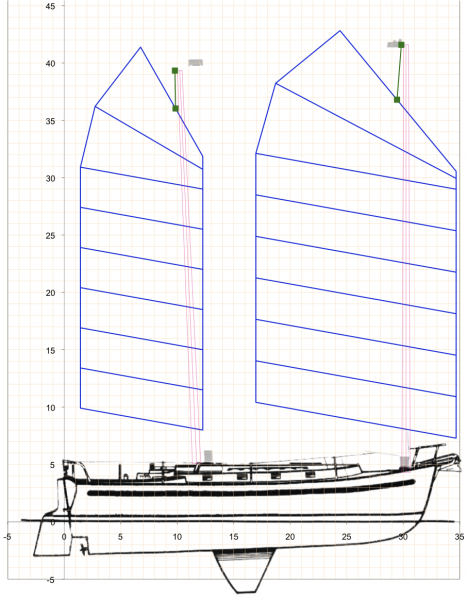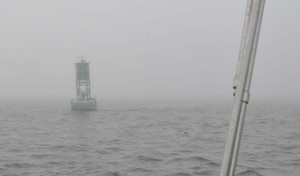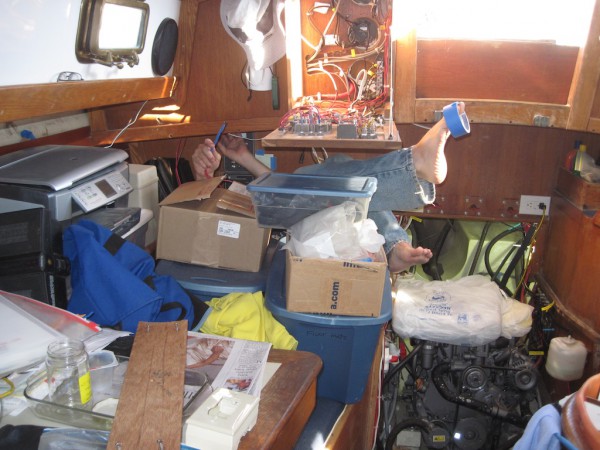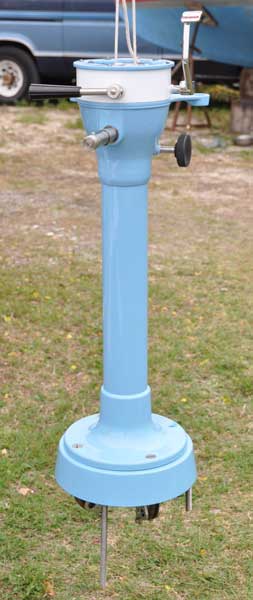Many people have expressed concern or fear about the idea of sailing a boat out on the open water when I mention our dreams and plans to launch Flutterby and sail, mentioning places like the Mediterranean as a possible destination.
I have a stock explanation that I offer up as some form of reassurance to them: Before there is a real disaster where lives or our floating home are at stake, it takes three bad things working together against us. They could be bad luck, or they could be just poor judgement and preparation on our part. This theory came from thinking about all the disaster sea stories I’ve heard, and I was always able to identify at least three things that went obviously wrong. Almost always, one of them is just bad luck, but usually at least two of them are simply poor judgement. Like taking inexperienced crew across the Tasman Sea, and then accidentally letting a halyard go during a storm. Actually that was just two, and it only resulted in a great story and two crew members who will probably never sail across an ocean again–no real harm happened that time.
The reassuring part is that you have the ability to not do many stupid things. I expect to be able to keep my stupidity list down to one at a time while sailing, requiring double bad luck to get me in real trouble. (We’ll see how this works)
On the other hand, when driving the Squid Wagon cross country, I feel like the stakes are lower–it would probably take more to make a really dangerous situation….but let me start counting:
Squidley is an old vehicle, and some things have degraded a bit, but I just put up with them. Like two out of four door locks that can be made to work, but don’t always work when you want them to, and in the way you want them to. Or door seals that let some rain in once in a while.
Stupid idea #1: The fuel gauge reads correctly when the rear tank is in use, but not when the front tank is in use. This happened a couple months ago and I figured it was easier to work around it than to fix it.
Stupid idea #2: The batteries died once or twice overnight for no reason I could understand. Rather than spend time and/or money chasing an (apparently) intermittent fault, we just disconnect the batteries when not using the vehicle overnight. With battery switches it is particularly easy. [I still don’t know if this plays into the story or not]
Bad luck #3: Something went wrong in the alternator or voltage regulator–and the alternator was putting out enough juice to really cook one of the batteries. Err…was this all just luck? I drove from La Fayette, Georgia to Spartanburg, South Carolina before I had really decided I had a problem and actually tried to deal with it.
Bad luck #3, part two: Found an auto electrical/alternator shop in Spartanburg (un-named to protect the guilty), which was at least pretty incompetent, and possibly did nothing at all. At I’m only out $80 or so. OK, they said they fixed the field wire shorted to ground, but the problem didn’t change. Then they said the put in a voltage regulator, and perhaps they did. Or maybe they just opened the field wire, so that the alternator wouldn’t overcharge my batteries. (I’ll figure out more when I really get this fixed)
I didn’t really figure out that the fix was bad until I made it from Spartanburg to Columbia and had a fantastic lunch with a friend. By then I was sure that the alternator wasn’t charging anything, and my batteries were slowly going down. But I figured I could keep driving quite a while like this.
Bad judgement #4:Â I’m ready to be back on the boat. I’ll try and push it and get back before I have to use my headlights (which would drain the (already low) batteries faster), and then address the problem in the boatyard with access to tools, guys to stare under my hood with me, auto parts stores, a loaner car and auto part stores.
Remember that fuel gauge that didn’t read what was in the front tank? I looked in the manual and figured that it was a 16 gallon tank. I figured I could probably get at least 15 out of it. So I tried driving 173 miles on that tank. It took 11 gallons at the next fill up. I used the non-reading tank first so whenever I got nervous I could switch to the one that told me when it was getting low. The next time I went 200 miles on it. 11.6 gallons. Then 235 miles. 14.3 gallons. By now I was getting pretty confident.
Bad judgement #5: (Meps, I know that if you were here, you would have told me so!) I decided to drive 250 miles on that tank. I dunno…maybe I was getting worse mileage because I was on a high speed limit interstate and driving fast to get home before dark (See #4). Well, now I know that the tank can get 15.9 gallons put back into it when it is completely empty.
So Squidley started slowing down, and I decided (too late) to switch tanks. I even tried to turn the engine over while rolling forward in neutral on the shoulder. (Yes, Meps, I really know you would have told me so now!)
For those of you lucky enough to have never run one fuel tank empty on Squidley, the process is now to crank the starting motor for a long time, to re-prime the diesel engine. Running the starter for over 30 seconds could overheat it, so stop at that point. I’ve found I usually have to crank the engine for 30 seconds about three times to get it started. After switching to the non-empty tank.
See Bad luck #3, #3 part two, and Bad judgement #4. The batteries barely had enough juice to turn the engine over once.
At this time, I hadn’t done a count, but I was reflecting on the fact that the margin for error on a road trip is greater than when crossing a large ocean in a small boat. I was pretty sure I had hit three by then. But this was driving, not sailing, and the result is a good story, not a disaster.
At this point, I changed into dirty jeans, got out my jumper cables and hung them on the mirror (Good judgement #1), and then started looking under the hood to identify my alternator, and wondering if the shop in Spartanburg had really put anything on there.
A truck driver heading home in his personal vehicle stopped and pulled around to me, and offered assistance after a little bit. (Good luck #2) It took quite a while but he finally managed to get enough juice into my batteries and starter to do the required cranking. Once I got started, we disconnected the jumper cables and I thanked him very much and headed off down the road. He later told me that he stopped and turned around because he saw the jumper cables hanging from my mirror.
Finally I decided to stop at a truck stop in Greensboro, and fill up that empty tank. The sun was just down, but there was still plenty of golden light. It would be another 40 miles to Kinston, the next likely truck stop.
I’m going to stay the night here, and leave in the morning. I may or may not need another jump start then, but if I do, it will only take 2 minutes instead of half an hour, since the fuel tanks are full and the fuel line is primed. Sitting here and writing this rather than pushing on makes good judgement #3. And I think the balance will make for a safe departure in the morning.




